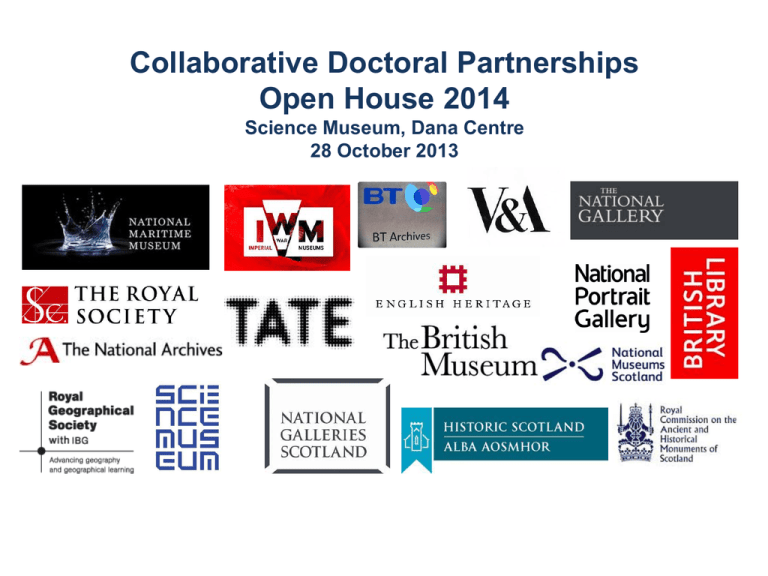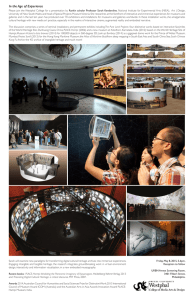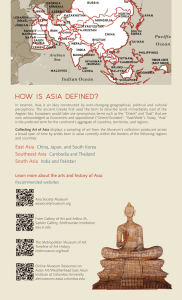Slides-for-CDP-Open-House-28th-October
advertisement

Collaborative Doctoral Partnerships Open House 2014 Science Museum, Dana Centre 28 October 2013 Example: SMG Research Priority Areas 2014 •Cross Group: –Conserving doped aircraft: historical origins; heritage outcomes. –How visitors understand historical scientific and technological objects •Science Museum: –Science and Technology in India, especially post-Partition –Linking music and science / technology in post-Enlightenment culture. –Timekeeping and metrology –Robots –The material culture of the history of medicine •National Media Museum: –Science, technology and art of photography, cinematography and TV, 19th & 20thc. –Relationships between different media and technologies; impact on culture and society. –Practical and conceptual challenges and implications of new digital technologies for the creation, storage, sharing and viewing of the still and moving image. •Museum of Science & Industry, Manchester: –International markets and consumption of Manchester/north west products –Social impacts of Manchester technologies and manufacturing •National Railway Museum: –Railways and modernism: how railways influenced, and were influenced by, modernism –High Speed Trains: technological, social & economic history from Shinkansen to HS2 V&A Research Priority Areas 2014 CDP Research Priority Areas for Years 2 (2014-2017) and 3 (2015-2018) • Latin American and African design history • Conservation-related research • Intersections between the history of science and the history of design • Fashion studies, particularly with a practice-based component • Design for Performance British Museum Research Priority Areas 2010-15 • • • • • • Objects, meanings and knowledge Food, drink and cuisine Ocean trade and connections Image and authority Technologies, materials and innovation Seeing the divine RGS Research Priority Areas • Global networks and the production and circulation of knowledge • Public Science/Geography • • Print culture and visual depiction in science (the journal records of both societies; scientific illustrations; mapping and cartography) • Expeditions/expeditionary cultures • Travel/travel writing • Under-researched parts of our collections are of particular interest. Examples include, but are not limited to: maps and atlases (RGS-IBG) Henry Bowman Brady archives (RS); Fellowship or diplomatic records (RGS-IBG); grant-giving and international scientific networks of the 20th century (RS) • Other topics highlighted include Water, science and culture; Water, energy and food security; Botany, gardens and health; Hazards, vulnerability and resilience; • Each year we expect to fund at least one project that builds on the RGS-IBG’s HLFfunded Crossing Continents project, engaging community groups. National Archives Research Priority Areas • • • Historical – The mechanics of 13th century government: organisation of business in the memoranda rolls – The mechanics of 14th century government: the course of the seal and the records it generated – Developments in early-modern science and technology – Legacies of Empire, slavery and indentured labour – Popular radicalism in the 18th and 19th centuries – Attitudes to vagrancy and poverty in the 19th century – Surgeons at sea: Royal Navy Medical officers' journals – The social impact of the First World War – British foreign policy in the Middle East (mid-19th to the mid-20th century) – The UK/US Special Relationship, 1945-1991 Heritage Science – Technical history to understand the making and meaning of cultural heritage collections, for example, wax seals, manuscripts, photographs. – Studying and understanding degradation mechanisms to interpret the meaning of cultural heritage; how degradation may affect the meaning and use of, and our association to heritage. Digital – Challenges in providing access to sensitive historical digital records – Challenges in identifying and linking individuals across muliple series of digital datasets SCHC Research Priority Areas • Creation, history and care of Scottish material culture • Analysis, interpretation and presentation of material culture • Impact and understanding of collections and the historic environment English Heritage Research Priority Areas Year 2 (2014-2017) • Agricultural and Forestry Impacts (NHPP 2D1): Understanding ploughzone archaeology • Historic Towns and Suburbs (NHPP 4A1): The significance of C19th and C20th built heritage in England • Public Participation and Enjoyment (Supporting Actons): Hidden heritage: alternative stories of key historic sites National Maritime Museum Research Priority Areas • New insights into the history of the Museum’s key sites, including the Queen’s House and the Royal Observatory • Post-1900 aspects of the Museum’s core collections and subjects: the history of art; the history of science and technology; and the naval and maritime history of Britain (with a particular emphasis on its social and cultural aspects • The history of post-1700 British maritime exploration and its legacies British Library Research Priority Areas •Britain and Latin America: Slavery, Independence and Empire, 1791-1888 •The Decca Record Company of the 1960s and 70s: the legacy of Christopher Raeburn •The evolving discursive construction of age and ageing: a multi-modal approach •Migrant and Refugee Scientists in the United Kingdom since World War Two •The Music of Thea Musgrave: an analysis based on the manuscript sources •Music, print and culture in the 16th century •The Russian Revolution •Stefan Zweig Collection Literary Manuscripts National Gallery Research Priority Areas General research • • Research on the NG collection of paintings from the 13th to the early 20th centuries Art historical, care and conservation, display, access (including virtual) and interpretation The National Gallery's four current research themes • The Meaning of Making Multidisciplinary technical study of paintings interpreted within the larger art historical context • Buying, Collecting, Display Research into collections, changing tastes and the evolution of the art market • Venetian Art and its History Collaborative study of the National Gallery’s Venetian paintings in the broader context of Venetian Art • Art and Religion Research that interprets paintings of sacred subjects

